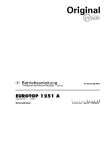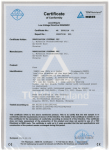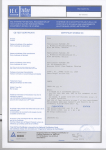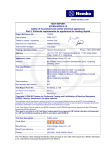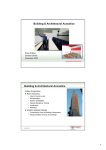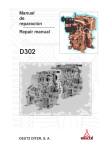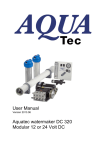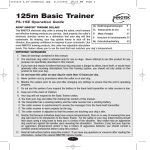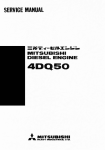Download BMW D7 Technical data
Transcript
Workshop Manual BMW D7 BMW Marine This copy of the BMW D7 Workshop Manual has been re-created using images computer scanned from a manual rather than original artwork. BMW D7 Marine Engine A four-stroke diesel engine with direct injection and open-circuit cooling system. The Neoprene impeller of the coolant pump is driven directly from the crankshaft. Electric starter and flywheel alternator are standard equipment. The injection system is fitted with automatic bleeding. Notes on Use This workshop manual describes complete procedures for dismantling, overhaul and assembly of the BMW D7 marine engine. If only part of the procedure is to be carried out (e.g. small repairs or replacement of gaskets, oilseals) the remainder can be ignored. The relevant technical data is provided with each section. General specifications are found on page iii. Assembly is generally a reversal of removal procedure. Special attention, however, should be paid to "notes on assembly". Checking and adjustment procedures, where applicable, are to be found at the end of the relevant section. i Contents Page Introduction i Summary 1 Removing cylinder head - Preparations - Valve mechanism - Valves - Cylinder head - Cylinder 3 3 4 5 7 7 Removing gearbox - Starter - Reversing gear - Bearing cover - Hand crank mechanism - Connecting rod - Piston - Fuel pump - Timing gear cover - Fuel regulator - Crankshaft - Valve lifters - Camshaft 8 8 8 9 10 11 13 14 14 15 16 19 20 Assemble crankshaft - Camshaft - Crankshaft - Fuel regulator - Timing gear cover - Fuel pump - Piston - Connecting rod - Hand crank mechanism - Bearing cover - Reversing gear - Starter 20 20 20 21 21 21 21 21 21 22 22 Assemble cylinder head - Cylinder - Cylinder head - Valves - Valve mechanism - Hoses & pipes 22 22 23 23 23 23 Adjust: - Valve clearance - valve timing - Decompression lever - Automatic decompression 24 24 25 26 Page Fuel System Remove, adjust: - Injection valve - Injection pump - Engine speed Check: - Injection pump - Injection valve - Fuel pump 27 27 29 31 32 32 32 Air filter 33 Electrical system - Wiring diagram - Generator - Starter motor 34 34 35 39 Water Pump 40 General ii Technical data Capacity Bore x stroke Max. power Compression ratio Dry weight with gearbox Gearbox reduction Max. installation angle 280cc / 17.1 cu.in. 73 mm x 67 mm / 2.87 in x 2.64 in 4.5 kw / 6 bhp @ 3600 rpm 22 : 1 68 kg / 150 lbs forward 2.7:1, reverse 1.9:1 o 15 Specifications Fuel Lubricating oil, engine gearbox Oil capacity, engine gearbox Fuel filter Air filter Injector Injection pressure Injection pump Starter motor Generator Battery Gearbox Diesel oil, DIN 51601/USA #2 HD-API CC/CD Hurth ATF Dexron - ZF SAE 20 W 20 2 litres / 3.5 pints UK / 4.4 pints US 0.4 litres / 0.7 pints UK / 0.85 pints US BMW 13 32 1 328 270 BMW 13 71 1 329 269 Bosch 135 + 8 bar Bosch PFR 1 K 70 A 343/II Bosch 0.8 kw 14V 350W 25A 12V 60 Ah Hurth HBW5 - ZF Bw 3 Adjustment data Injection ends Valve clearances, cold o o 11.5 - 12.5 BTDC 0.15 mm / .006 in. Torque settings Cylinder head nuts M 8 Nm 40 kpm 4.0 Connecting rod screws 40 4.0 Counter weight screws 22 2.2 M 6 hex nut for the mounting of the injector Flywheel bolts M 10 Injection pump delivery valve M 6 hex head screw for fastening bearing cover retaining yoke on the flywheel side Nozzle nut 10 70 40 10 1.0 7.0 4.0 1.0 85 8-9 Remarks Use permanently elastic sealing compound (e.g. Atmosit) on the stud screws in the oil space! Oil threads and screw head insert lightly Oil threads and screw head insert lightly iii List of Special Tools D7 BMW Part No. Description 74 64 1 333 525 74 64 1 333 526 74 64 1 333 513 74 64 1 333 514 74 64 1 333 515 74 64 1 333 516 74 64 1 333 517 74 64 1 333 527 74 64 1 333 535 74 64 1 333 528 74 64 1 333 536 74 64 1 333 529 74 64 1 333 530 74 64 1 333 531 74 64 1 333 537 74 64 1 333 538 74 64 1 333 539 74 64 1 333 540 74 64 1 333 518 74 64 1 333 519 74 64 1 333 520 74 64 1 333 541 74 64 1 333 521 74 64 1 333 542 74 64 1 333 532 74 64 1 333 543 74 64 1 333 522 74 64 1 333 523 74 64 1 333 524 74 64 1 333 544 74 64 1 333 545 74 64 1 333 546 74 64 1 333 547 74 64 1 333 534 74 64 1 333 548 74 64 1 333 549 74 64 1 333 550 74 64 1 333 551 74 64 1 333 552 To refit ball hub To refit crankshaft gear Crankshaft installation tool Puller for valve lifter shaft Tool for crankshaft removal Tool for camshaft needle bearing installation Wrench for injection adjuster Crankshaft gear puller Tool for adjustment of injection pump Tool for injection adjuster Multi purpose extractor Auxiliary wrench for cable connector Sleeve 27 - 36 mm internal extractor Counter support-internal extractor Allen socket with center pin 8 mm Allen socket with center pin 10 mm Clamping holder to grind valve-valveseat Allen wrench 6 mm elongated Auxillary bush-oil seal Punch - needle bearing camshaft Socket 13 mm (long size) Allen socket 6 mm Retaining bracket for cylinder Press-in mandrel-valve guide 7 mm Ø Hand reamer 7 mm Ø H 7 for valve guide Flare nut wrench 17/19 mm Special tool for governor spring Box wrench 10mm Piston ring clamp Measuring device for bumping clearance Testing device for injection equipment Dial gauge 1/100 mm Torque wrench 1 - 140 NM Guiding pin 7 mm Ø (valve reseating tool) Handle for valve reseating tool Piston ring pliers Allen socket 8 mm Valve reseating tool 42.5 mm Ø Gudgeon pin extractor iv Summary BMW Marine Diesel Engine D7 Description: Water cooled single cylinder four stroke producing 4.5 kW (DIN) (6 Hp) 1. 2. 3. 4. 5. 6. 7. 8. 9. 10. 11. 12. Cylinder head cover Decompression lever Throttle cable mount Hand crank attachment Cover Sea water pump Fitting Hose clips Sea water hose Engine mounts Cylinder head Metering device 13. 14. 15. 16. 17. 18. 19. 20. Fuel return hose Injector Air filter Fuel injection pipe Injection pump Throttle Dipstick Oil filler screw General 1 Summary 21. 22. 23. 24. 25. 26. 27. 28. Exhaust Starter Retainer yoke Gear box Crankcase Fuel pump Fitting Sea water pipe CAUTION To avoid damage to engine parts, always use special tools as shown in the illustrations. The tools to be used fit only in the position shown. General 2 Cylinder Head Removing cylinder head and cylinder CAUTION - Remove air filter (1) Loosen sea water pipe from exhaust manifold and water pump and remove (2) + (3) - Disconnect fuel return hose from injector and remove (4) Disconnect fuel injection pipe from injector and injection pump and remove (5) Remove clip of crankcase vent hose (6), unscrew both nuts of the rocker cover and remove the rocker cover with gasket (7) - Detach Disassemble Remove Cover all openings in the fuel system Air filter, seawater hose, fuel overflow hose, cylinder head vent hose clip, cylinder head cover with gasket, rocker shaft with rockers, pushrods 3 Cylinder Head - Remove rocker shaft with bushing and retainer yoke and remove rockers (8) and (9) Pull out both pushrods Cylinder Head Repair Data Dimension D7 nominal values Max. allowable wear (mm) 0.05 Rocker arms shaft dia. mm 18 -0.027 Rocker arm internal dia. mm 18 Rockaer arm radius mm 8 Valve seat angle Detach Disassemble Remove o +0.024 +0.006 0.05 Remarks After press fitting No flats 45 Rocker shaft with rockers, pushrods 4 Cylinder Head, Timing Gear - Remove decompression lever from the underside of the cylinder head (10) Unscrew the M10 nut and unscrew stud bolt. Remove the spring Remove retaining pin with pointed pliers Unscrew inner clamping sleeve on gear segment and remove shaft and gear segment. Remove valves & valve springs (11) Press down the spring retainers WARNING Danger of injury due to spring retainers and valve keys popping out. - Loosen both key halves while applying pressure from below and remove with pointed pliers. Remove cap and washer from under the valve spring Remove valve Press out the valve guides from below NOTE When pressing in the new valve guides, when parts are cold note minimum force of 1000 N (approx 100 kp) - Ream the valve guides o Rework leaky valve seats with a 45 valve seat cutter. Mill only enough to remove spots from valve seats. Reseat valves using auxiliary tool No 74 64 1 333 539 Detach Remove Rework Decompression lever handle, clamping sleeve on handle, spring shaft, valve poppets, spring plate with valve spring, cone halves, valve guides 5 Cylinder Head The valves should sit back as measured from the seating surface of the cylinder head, according to the following table: Cylinder Head Dimension Repair Data Valves D7 nominal Max. allowable values wear (mm) Valve clearance cold mm 0.15 Intake valve stem dia mm 7 -0.04 -0.05 0.05 Exhaust valve stem dia mm 7 -0.05 -0.04 0.05 Intake valve disc dia mm 30.5 Exhaust valve disc dia mm 30.5 Valve sit back max mm 0.70 Valve sit back min mm 0.45 Valve guide bore mm 7 +0.09 0 Outer diameter mm 10 +0.023 +0.029 Valve guide bore in cylinder head mm 10 +0.0011 kp 100 Valve guide press in force Remarks CAUTION! Valve sit back may not be less than 0.45 mm as otherwise the danger exists that the valve disc hits the piston. 0.05 The sealing surface of the cylinder head can be reworked to a maximum of 0.5 mm if the sit back of 0.7 mm is exceeded due to valve seat milling. With the cylinder head cold. Table: Valve sit back 6 Cylinder Head / Cylinder Remove cylinder head and pull off cylinder (12) The cylinder head is unusable in the following cases: Sealing surface fouled or damaged i.e. uneven Clean the sealing surface and re-grind, observing the tolerances Valve seats worn out or no longer suitable for re-facing. Cracks in the valve seats in the cylinder head NOTE Measure cylinder bore with a cylinder indicator In the following cases, the cylinder is unusable: - Cylinder Bore dia Dimension mm Roughness Ra Oversizes Seize marks are found in the bore Scratches are present Wear exceeds 0.15 mm Repair Data Cylinder D7 nominal Max. allowable values wear (mm) 73 + 0.01 Remarks 0.15 1.0 – 1.2 mm +1 Remove Unusability of cylinder head/cylinder Detach Cylinder head, cylinder 7 Bearing cover Remove starter (13) - Remove attaching clamp of the cable to the stator and remove starter Remove the four cyclinder screws M 10 and remove the flywheel (15) and (16) Remove gearbox (14) complete with flywheel cover. Remove bearing cover Detach 8 Bearing cover NOTE - After loosening the four M6 hex screws, remove the bearing cover with locking plate and the sealing ring located on the inner face (17) Bearing cover can be replaced when the engine is cold Remove bearing cover Detach 9 Cover to timing gear cover / timing gear cover / hand cranking device - Remove screws from cover of timing gear cover and take off the cover (18) - Remove hand crank mechanism (19) with extractor tool No 666 332 00 Detach Cover of timing gear cover, hand crank device, dipstick, cover on engine bottom, Remove connecting rod 10 Dipstick / cover on engine bottom / connecting rod - Turn the engine on to the flywheel side (23) and remove dipstick (24) - Remove cover and O-ring from crankcase on the engine bottom (25). - Unscrew the two connecting rod screws (26). Take out connecting rod cap with oil pick-up (27) from below and piston and connecting rod (28) from top. Detach Remove Dipstick / cover on engine bottom / connecting rod 11 Table: Repair data for connecting rod and connecting rod bearing Repair Data for con-rod bearing and con-rod Con-rod bearing Dimension D7 nominal values Max. allowable wear (mm) Remarks Minimum bearing play = 0.040-0.076mm when new Outer dia mm 46 Inner dia mm 42 Width mm 26.5 Undersize mm 41.5 Con-rod bearing wall thickness normal(W) mm 1.998 Con-rod bearing wall thickness oversize(WU) mm 2.248 +0.02 Gudgeon pin bushing bore dia mm 28 +0.013 Con-rod bearing bore dia mm 46 +0.010 +0.016 -0.026 see table on page 17 max wear to 0.15mm see table on page 17 +0.02 Total play after wear: max 0.15mm Con-rod Gudgeon pin bushing: outer dia mm 28 inner dia – loose mm 25 - installed mm 25 0 -0.006 +0.048 +0.035 +0.082 +0.068 0.20 +0.020 +0.007 Thread con-rod bolts M8 12 Piston Note Heat piston to remove piston pin - Remove the gudgeon pin snap rings and press out the gudgeon pin by hand while the parts are still warm (29). In the following cases, the piston is unusable: ring land between the rings broken piston scuffed ring groove worn out and cracked Piston rings are unusable when the gap is too big Repair Data Piston Dimension D7 nominal values Piston dia mm 72.96 Oversize mm +1.00 Overall length mm Piston ring gap (new condition) mm Unscrew Detach Max. allowable wear (mm) Remarks 82mm 0.25 – 0.4 Up to 2.00 Piston 13 Fuel pump / timing gear cover - Remove fuel pump (29a) - Remove pump plunger (29b) - Unscrew the three M16 hex nuts and remove timing gear cover (29c) Detach Fuel pump, pump plunger, timing gear cover Remove 14 Fuel regulator, gear on crankshaft - Bring engine into the horizontal position, as shown in Fig (29d) Remove gear from crankshaft using extractor tool (29k) Loosen M6 hex nut (29f) on the regulator lever and pull out locking pin with pointed pliers Unscrew both M10 hex nuts (29e) from regulator shaft. Remove regulator shaft together with round nut, spring washer, sealing ring and friction disc. Unscrew M8 hex nut. Withdraw eccentric bolt with cap plate and sealing ring Loosen M20 hex nut. Remove start filling (29h) with sealing ring. Pull out clamping sleeve, using pointed pliers. Withdraw regulator lever with regulator spring (29i) Turn engine on flywheel side. Repair Data for Regulator Spring Washers Maximum rpm 3600/160 No of balls 4 Regulator Spring BMW Part No 13 41 1 329 652 Wire Dia 2.6 Remove Regulator lever with regulator spring 15 Ball sleeve / Crankshaft - Remove ball sleeve with sliding disc taking care that no balls fall out (30) Ball hub and spacer washer (31) remain on crankshaft. Detach these parts only when removing the crankshaft. - Turn the engine block into the horizontal position. Removing the crankshaft NOTE It is essential that all plastic parts such as oil filler cover and cold start cover are removed - Heat the crankcase on a heating plate to between o 80 and 100 C (32) Press out the crankshaft with extractor tool (33) 74 64 1 333 515 Press off the roller bearing on timing side (33a) Press off straight roller bearing together with spacer washer and drive dog hub (34) Remove Ball sleeve, crankshaft 16 Crankshaft The outer race of the straight roller bearing on the timing gear side remains in the crankcase and can be removed with the aid of a press In order to remove the bearing rings which have been shrunk on to the crankshaft (35) heat the crankshaft on a heating plate or with a sufficiently o large gas burner rapidly to about 70 to 80 C After removal of the M8 cylinder head screws, remove the counterweights (36). Set the crankshaft on a solid support and loosen bearing race by a blow to the crankshaft. Repair Data for Crankshaft Crank Pins Crank pins must not become convex upon regrinding. A concave shape of from 0.01 to 0.02 mm in diameter in the mid portion of length is allowable. Crank pin nominal diameter (D) 42 -0.060 +0.074 mm Crank pin diameter undersize (DU) 41.5 -0.060 -0.074 mm Total play when worn out max 0.15mm Remove Crankshaft 17 Table: Repair data for crankshaft Repair Data for Crankshaft Crankshaft Crank pin dia Dimension mm End float D7 nominal values 42.0 -0.060 -0.070 Max. allowable wear (mm) Remarks Total play 0.15 max Max allowable crank pin out-of-round 0.05mm Grinding finish see page 17 Hardness at least 48 RC 0.3 +0.068 0 Crankshaft crank pin width mm 33.0 Radii on crank pin mm 3.0 Hardness of crank pin RC 50-55 Depth of hardening of crank pin mm 1.1-1.5 Diameter of ball hub (regulator) mm 29.0 +0.021 0 Diameter of ball sleeve mm 28.0 -0.020 -0.041 Diameter of gear on crankshaft mm 22.0 +0.048 +0.035 Regrinding of crankpin mm 0.5 Axial play mm 0.3-0.4 18 Valve lifters and camshaft - Remove the plastic plug from the side of the engine block (37) Unscrew the M8 set screw (38) with a 4 mm Allen key and remove together with plug CAUTION When removing the camshaft, lift off both rockers from the camshaft to prevent damage by the cam lobes - Pull out valve rocker shaft with the aid of extractor tool No 74 64 1 333 514 (39) - Remove valve rockers together with washer (39b, 39c) Replace valve rockers if worn. Withdraw camshaft Press roller bearing off the camshaft Rotate crankshaft so that the needle bearing becomes accessible. A damaged camshaft needle bearing can be removed from the crankcase with drift punch No 74 64 1 333 519. - Remove Valve lifter shaft, valve lifters, camshaft, roller bearing 19 Crankshaft Camshaft Reassembly of the engine parts is carried out in the reverse order. Installing the crankshaft NOTE The tooth gear on the camshaft is marked with the letter “L”. This indicates the direction of rotation of the engine as viewed from the front. - - CAUTION Drive in the rear camshaft bearing using the assembly punch No 74 64 1 333 516. Install the camshaft. Screw in the set screw and replace the plastic plug. Insert the valve lifter shaft and tighten, so that the valve lifters show a minimum of axial play but are still free to move on the valve lifter shaft. NOTE The crankshaft bearing is asymmetrical. The correct position is that shown in the illustration (41). The large rounding must be placed towards the outside, to ensure sufficient lubrication. - Take care that the thrust washer is placed between the valve lifters and the crankcase to prevent the valve lifters from wearing into the aluminium case. Push the crankshaft with bearing into the heated crankcase from the flywheel side, until it reaches the stop of the special tool. CAUTION When installing the crankshaft, make sure that the axial play between the crankshaft and crankcase is between about 0.2 and 0.4 mm. - Install Camshaft, Valve lifter shaft, valve lifters Attach the counterweights, tightening the bolts to a torque of 2.2 kg/m (16 lb/ft) Heat the inner race of the roller bearing to o between 70 and 80 C and mount on the crankshaft. Place the retainer ring on the outer bearing race. Push inner straight roller bearing onto the crankshaft together with spacer washer and drive dog hub. o Heat the crankcase to between 100 and 150 C on a heating plate. Push the outer race of the bearing on the flywheel side onto the crankshaft and screw it on using special tool No 74 64 1 333 513 Replace all plastic parts such as oil filter cover and cold start cover Turn the engine back onto flywheel side and place ball sleeve with sliding disc into position. Take care that the balls are inserted correctly. Crankshaft, ball sleeve 20 Fuel Regulator / Gear on the Crankshaft Timing gear cover / Fuel pump - Set the engine block into the horizontal position Insert regulator lever and regulator spring Insert clamping sleeve into the regulating spring with pointed pliers Install start filling sealing ring and tighten M20 hex nut Install eccentric bolt with cap, plate and sealing ring. Insert regulator shaft and tighten both M10 hex nuts. Insert stop pin into the regulator lever and tighten hex nut. Connecting Rod Crankcase cover / dipstick / bearing cover Install connecting rod in such a manner that the scoop is filled through the scoop opening when dipping into the lubricating oil. Scoop opening must point in running direction. The lubricating system is based on the centrifugal principle. CAUTION Set the cylinder slowly with great care onto the piston so that no piston ring is broken or damaged. Observe that the opening in the combustion chamber located in the piston crown points towards the flywheel side. Install gear on the crankshaft - - - Before assembly, heat the cog for the crankshaft on a heating plate or in an oil bath to o approx 80 C and assemble with tool No 74 64 1 333 526 When mounting the cog onto the crankshaft, take care that the marking on the cog opposite the key groove points to the outside - Install crankcase cover with seal into the underside of the engine block Insert dipstick Turn engine block to the horizontal Assemble starting crank mechanism with extractor tool No 666 332 00 Screw on the cover to the timing gear cover Mount bearing cover Turn engine block onto flywheel side. When mounting the timing gear cover, adjust the cog on the camshaft and the cog on the crankshaft so that their markings are opposite each other. CAUTION In order to avoid damage to the bearing cover during assembly, use auxiliary bushing No 74 64 1 333 518 Check upper dead center and overlapping. - Mount the timing gear gear cover with light taps of a hammer and tighten both M16 hex nuts NOTE It is imperative that copper washers be used for the timing cover screws - - Insert pump tappet and mount fuel feed pump Before assembling the pistons, heat them on a hot plate. Insert gudgeon pin and the gudgeon circlips. Turn the piston ring gaps of the two piston rings o and of the oil scavenge ring 120 to each other Lightly oil the threads and the screw head inserts of the connecting rod parts Insert the connecting rod bearing half with the hole into the connecting rod cap Insert the connecting rod bearing half without the hole into the connecting rod Assemble the connecting rod. Tighten the connecting rod screws with torque wrench and 6mm socket No 74 64 1 333 541 to torque of 40 Nm (4 kpm) Install Regulator lever, regulator spring Mount Regulator shaft, cog on crankshaft Fill the groove in the bearing cover between packing washer and dust lip with ball bearing grease Mount the sealing ring on the inside of the holder, onto the holder with grease in order to prevent slipping during assembly. Insert the thrust ring into the dry bushing with the graphite coated side towards the outside. Mount the cog onto the camshaft without Woodruff key and tighten NOTE The marking of the cog on the camshaft must align with the Woodruff key groove. - Coat the sliding surface of the dry bushing with molykote grease Insert the cog with needle bearing into the dry bushing Fill the housing with approx 100g of hot bearing grease e.g. “Calypsol WDT” or equivalent quality and assemble with gasket. Timing gear cover, connecting rod Cover on crankcase, starting crank device, cog on camshaft 21 Flywheel / Stator / Reversing Gear / Starter / Cylinder head - Fasten the stator in the crankcase and screw on the attaching clamp Install the flywheel. Tightening torque of the flywheel screws is 7.0 kpm Attach the reversing gear Attach the starter - Adjust the gap with a corresponding cylinder foot gasket The gasket set contains gaskets of various thicknesses. NOTE When installing the cylinder head pay close attention to the following points. It is imperative that a new cylinder head gasket be used and pay close attention to valve sit back and tightness Tightness is checked by filling fuel into the intake or exhaust channel. If nothing leaks through, the valve seat is tight. CAUTION Do not damage the rubber sealing rings for the decompression lever, resp. decompression shaft and stop pin After replacing cylinder, piston, connecting rod, crankshaft or crankcase, measure the gap between cylinder and piston upper surface at TDC (42). - Mount the completely assembled cylinder head onto the cylinder Fasten the cylinder head with the aid of socket wrench No 6425 evenly and crosswise with the required tightening torque. Tightening torque of the M8 hex nut on studs (tension rod) for the fastening of cylinder and cylinder head – 35 Nm (3.5 kpm) Use the measuring bridge No 74 64 1 333 544 and clamping piece No 74 64 1 333 546 with measuring gauge, for measuring the gap. NOTE Oil threads lightly. However, do not use molykote. Seal locking screws in the oil space of the cylinder head with a permanently elastic sealing compound (e.g. Atmosit or similar) Repair Data CAUTION Cylinder Head Dimension D7 nominal values Piston gap (A) mm 0.55 – 0.65 Cylinder head (b) gasket mm 1.50 Cylinder shim mm 0.1/0.2 If the gap is too small piston, cylinder head and valves may be damaged. If the gap is too large, the engine loses performance. Assemble Flywheel Test Valve seat tightness, piston gap Cylinder head 22 Cylinder head / Injection pipe / Leak-off-line / Water pump / Water hose / Air filter - Press in valve guides from underneath Insert valves Insert valve springs with cap and washer Insert spring plate Insert both valve keys, while applying counter pressure to the valve Insert shaft with gear segment and screw in internal clamping sleeve. Slide handle with ring onto the shaft and screw in external clamping sleeve. Insert push rods Insert rocker arms and assemble rocker shaft with bushing and retaining plate (43) NOTE Check that the rocker arms are free to move - Adjust valve clearance Fasten cylinder head cover and vent hose clamp with both nuts Fasten injection pipe to the injection pump and to the injector Attach leak-off-line hose to the injector Install water pump Fasten water hose to the water pump and to the exhaust manifold Attach air filter Assemble Valves, push rods, rocker arms, cylinder head cover. Install Injection pipe, leak-off-line, water hose, air filter 23 Timing gear adjustment Adjust valve clearance and timing The following must be carried out: - NOTE Carry out the testing and adjusting when the engine is cold. - Set the decompression lever to “0” Remove cylinder head cover Crank the engine in rotation direction until the compression resistance can be felt Check valve clearance between rocker arm and valve shaft with a feeler gauge In the case of incorrect valve clearance, loosen the lock nut and adjust the set screw with a screwdriver so that the feeler gauge can be pulled through between the rocker arm and the valve shaft with noticeable resistance after the nut is re-tightened Repair Data Valves Cylinder Head Dimension D7 nominal values Max. allowable wear (mm) Valve clearance cold mm 0.15 Intake valve stem dia mm 7 0.05 Exhaust valve stem dia mm 7 0.05 Intake valve disc dia mm 30.5 Exhaust valve disc dia mm 30.5 Valve sit back max mm 0.70 mm 0.45 Outer diameter mm 7 Valve guide bore in cylinder head mm 10 mm 10 kp 100 Remarks CAUTION! Valve sit back may not be less than 0.45 mm as otherwise the danger exists that the valve disc hits the piston. Valve sit back min Valve guide bore Valve guide press in force 0.05 The sealing surface of the cylinder head can be reworked to a maximum of 0.5 mm if the sit back of 0.7 mm is exceeded due to valve seat milling. With the cylinder head cold. Adjust Valve clearance 24 Decompression lever adjustment If the engine is not decompressed in Position “1” of the decompression lever, adjust the decompression screw as follows: Crank the engine to the same position as in the valve adjustment Turn the decompression lever to Position “1” After loosening the hex nut, turn the adjusting screw to the right until the rocker arm touches the valve shaft From this position, turn the adjusting nut another quarter (¼) revolution to the right and secure by tightening the nut. The engine is equipped with automatic decompression. Function: - If the handle is set to Position “2”, cranking the motor automatically turns the handle further to Position “0” (compression) A specially designed tappet turns the decompression shaft further with every raising of its valve. Extract the clamping sleeve of the gear segment on the valve shaft with pointed pliers and dismantle the decompression shaft with gear segment. Installing the automatic decompression system NOTE The hole for the clamping sleeve in the gear segment, viewed from the flattened side of the shaft, lies towards the outside of the engine. In this arrangement, the automatic decompression is operated by the left tappet (when looking towards the timing gear side). The decompression handle turns clockwise. The length of the tappet (with collar) is adjustable. The standard length is 147.8 – 148 mm Adjust Automatic decompression 25 Timing gear adjustment Correction is required in the following cases: If the collar pan constantly engages the cog lightly, in the case of running the engine and zero position of the decompression lever (Shaft moves back and forth) In this case, shorten the tappet somewhat and dimension “A” will become larger (see figure) - The decompression shaft is not rotated further properly from position “2” of the handle In this case, lengthen the tappet somewhat and dimension “A” will become smaller (see figure) Correct the position of the collar pan to the cog (lateral distance) by a small movement of the rocker arm shaft on the cylinder head plane. NOTE Choose distance “B” so that certain functioning of the automatic system is ensured. In the running position of the engine (lever position “0”) the collar pan may not touch the cog. Fix the cog segment on to the shaft so that the cogged area is on the upper side when the flattened part of the shaft points upward. Adjust Decompression lever 26 Injector Injector check Check injection valve for: - CAUTION Function Injection pressure (ref figure with pintle type nozzle) Be sure to observe a maximum of cleanliness when working on the fuel system - Remove injection pipe and leak-off-line Loosen M6 hex nut and remove injector from the cylinder head together with holding bracket NOTE During removal and installation of the injector, pay attention to the sealing washer in the cylinder head Position of the sealing disc: the side with a recess towards the injection nozzle. The sealing washer must seal properly. Fuel Injection Equipment Remarks Injection Pump Bosch type code Bosch No BMW Part No PFE 1Q 55/19 0 414 050 996 1351 1329 656 Injector Assy Bosch type code Bosch No BMW Part No 0432 297 022 1351 1329 667 Nozzle Bosch type code Bosch No BMW Part No DNO SD 21 0434 250 001 1353 1329 669 Injection pressure 135 bar Remove Injector With second hole in housing (for automatic venting) Check Injection system 27 Injection pump - Adjust the injection pressure by inserting or removing shims at the injector spring NOTE A shim with a thickness of 0.1 mm changes the pressure by approx. 15 bar - Injector overhaul Extreme cleanliness is necessary during work on injector. - Unscrew the screw cap and remove the injector nozzle Unscrew sleeve nut F (22 mm) and withdraw injector jet G Clean jet with correct apparatus, not with sharp tool, wire brush or similar. All traces of carbon should be removed. Injector should be replaced as a complete unit if: CAUTION Clean the nozzle only with a Bosch nozzle cleaning device. Do not use hard objects as steel brushes, wire or similar. Carry out the cleaning and testing of the nozzle with a maximum of cleanliness, rinse injector parts in clean fuel only. Microscopically small particles can lead to wear and malfunction. - Jet needle H is damaged or eroded Overheating of the needle and jet has occurred (blueing) Taper of jet needle does not seal NOTE A malfunctioning nozzle leads to, amongst other things, poor combustion (black exhaust smoke), poor performance and overheating of the cylinder head, piston and cylinder. Injector operation check and adjustment This should be carried out as completion of checking operation of injector pump. With special tool 74 64 1 333 545 fitted to injector pump. See page 32 Remove Injector nozzle 28 Injection pump Preliminary tasks before removing the injection pump: The injection pump has two hose connectors and a pipe connection. The lower connection is for the fuel supply, the upper connection is designed for the fuel return hose. The start maximum fuel eccenter must be turned in such a manner that the eccentric arm points vertically upward before installing the injection pump. - - Remove the injection pipe Clamp off the fuel supply line Pull off fuel return hose and fuel supply line from the injection pump NOTE Set the engine throttle to the full position without pulling the start filling lever when removing the injection pump. - Remove the injection pump hex nuts and pull out the pump Bring the regulator lever into the center position by slightly adjusting the position of the eccentric shaft. Rotate the plunger on the injection pump The bolt must be exactly in the middle of the groove in the pump housing. - Insert the shims and carefully slide injection pump in without shifting the regulating bushing NOTE Pay attention to the shims between the pump and crankcase and the washer in the pump tappet. - First install the fuel supply line, then fasten the valve. When installing the injection pump, rotate the camshaft so that the injection pump tappet lies on the camshaft basic radius (lowest position). - Set regulator lever with the aid of the throttle Remove Injection pump 29 Injection pump NOTE Slide the pump in to about the last 4 mm without overcoming any resistance. Only then may resistance occur due to the tension of the tappet spring Preliminary work: - - This tension can be overcome by a small pressure and the pump pushed in completely by hand. Clamp off the fuel supply line Unscrew injection pump pressure valve holder. Remove spring, sealing ring, valve cone and pressure valve (see figure) Screw in adjusting device No 74 64 1 333 535 with sealing ring and pressure valve body If this is not possible, the plunger pin is interfering with the regulator lever. CAUTION A fastening of the pump in this position would cause serious damage to the pump, regulator lever and, in some cases, to the engine (during start, because of a blocked regulator) - Determine the correct position of the injection pump: (1) Move the throttle in both directions. The regulator lever must audibly reach its stops. (2) Remove the injection pipe together with delivery valve holder NOTE When moving the throttle and the start filling button, the pump plunger must rotate - Screw down the injection pump after the completed check Connect the fuel supply line and fuel return hose Adjust injection pump Set throttle into position “START”. Do not pull cold start filler. - Set flywheel to approx 2.00 mm before top dead center (observe direction of rotation) The marking for tope dead center (OT) as well as the degrees for the injection pump timing are located on the flywheel The countermarking on the crankcase is located on the flange thread hole on the upper right (when looking at the flywheel) Insert dial indicator with extension pin with the zero setting at 1.00 mm and clamp (45) Open the fuel supply line. Fuel free from air must flow from the adjustment device. Injection Pump Adjustment Injection timing – delivery end in degrees before TDC 11.5 – 12.5 Delivery stroke in mm 1.40 NOTE The injection pump of this engine has the helical groove on top of the plunger. The adjustment of the injection timing and delivery stroke is therefore done at the injection end. Adjust Injection pump 30 Injection pump Adjustment of the delivery end: - - Crank the engine in the direction of rotation until the fuel stops to flow from the adjustment device Slowly crank further, until the fuel just begins to flow again After the adjustment is completed remove the dial indicator and install the completely assembled delivery valve with injection pipe in the correct sequence. NOTE NOTE The number of degrees indicated on the flywheel must correspond with the nominal o values (11.5 – 12.5 BTDC). If the values do not correspond, correct with the shims inserted under the pump. Pressure valve body with the exterior truned groove lies in the direction of the pump tappet. When screwing in the injection pipe, replace the internal copper sealing ring and the external O-ring. Observe tightening torque. Basic rule: CAUTION More shims = delivery ends later (lower number of degrees) Less shims = delivery ends earlier (higher number of degrees) When adjusting rpm it is imperative that a tachometer is used In order to determine which thickness of shims must be removed or added, rotate the flywheel to the required number of degrees from the delivery end already determined (dial indicator set at zero) NOTE The camshaft is geared down in a ratio of 1:2. The rpm measured there must therefore be multiplied by 2 in order to arrive at the nominal rpm The value shown on the dial indicator corresponds to the thickness of the shims which must be added or removed in order to compensate for the difference. NOTE Repeat the procedure after the adjustment as a double-check - Set the delivery stroke at the correctly set delivery stop. Set the dial to zero. Rotate the flywheel against the direction of rotation until the dial indicator indicates the delivery stroke value. Hold the flywheel at this position. At this point fuel must just start flowing out of the leak-off-line. If this does not occur, loosen the start filling lock nut with wrench No 74 64 1 333 517 and carefully turn the eccentric shaft with wrench No 74 64 1 333 528 until the fuel begins to flow. - - In order to adjust the rpm, remove the plastic plug and loosen the retaining nut Turn the eccentric shaft, recognisable from the outside only as a set screw, with the aid of a screwdriver, until the desired rpm is reached Move the throttle in the direction of STOP briefly after each adjustment of the eccentric shaft and then bring the throttle to the full throttle stop position Check injection pump and injection valve for correct function (46) After having correctly adjusted the rpm, fasten the retaining nut again and insert the plastic plug Preliminary work for the functional check of the injection pump and injection valve Subsequently tighten the locknut again NOTE - Remove injection pipe - Vent the engine correctly As a check, also repeat this adjustment. Adjust Injection pump Adjust Engine speed 31 Injection pump / Injector - NOTE WARNING Carry out the check with the throttle in the fully open position and with the starting filling not pulled. Danger of injury due to the fuel jet After installing the testing device No 74 64 1 333 545 of which the connections at the sides must be closed off, crank the engine by hand until the pressure gauge shows a pressure of 300-350 bar WARNING Danger of Injury - Venting Injection pump Fuel pump As the engine has automatic fuel system venting, the necessity for a manual venting does not apply, as the trapped air in the injection pump escapes through the return line during the filling of the pump with fuel. Due to the pulsating of the feed pump, the restrictor causes a constant flow of fuel in the injection pump. Possible gas bubbles are automatically drawn off, thereby service interruptions resp. interferences are prevented. NOTE Stop cranking and watch whether the pressure is maintained. If the pointer falls back, and if the pump does not maintain a pressure of 250 bar either, the injection pump is defective In the case of possible service interferences and after longer periods of engine standstill check the functioning of the vent valve. NOTE During the testing, the injection valve can be connected to the testing device in place of a blind plug. WARNING Danger of Injury - If this is not the case, stop the engine and unscrew the vent valve - - When cranking the engine by hand, watch the injection pressure on the pressure gauge and the function of the injector Crank the engine with the handcrank resp. starter and remove the vent valve at entry to the fuel tank Fuel must pulse from the fuel line - Clean the valve with fuel and compressed air, resp. replace the valve When cleaning the fuel supply pump, unscrew cover and remove filter. Clean the fuel filter, especially under protruding corners of the cover Insert the filter again, fasten cover. Correct function “a” Incorrect function “b” Check Injection pump, injector Check Clean Fuel jet, venting Fuel pump 32 Air filter Cleaning the air filter - Loosen clips. Remove filter element. Remove sealing ring from cover and clean groove Install new sealing ring and filter element. NOTE Never use an old filter element - Clean air intake openings and pipe in the filter NOTE Premature engine wear occurs if unfiltered or badly filtered air is drawn in through a badly maintained air filter Clean Air filter 33 Wiring diagram 34 Generator and generating equipment Preparation Remove starter motor Detach gearbox/clutch cover assembly Remove clutch Remove flywheel Rotor Removal Extract spring clip A from flywheel magnet by inserting snip-nosed pliers into cut-outs provided - Generating Equipment Removal Disconnect leads from temperature sensor and remove stator cable plug C from socket on equipment carrier Remove bolts D (13 & 19 mm), noting position of spacers, washers and injector pipe clip (if fitted) and remove carrier and equipment complete from engine. Pull magnet B from flywheel with even movement, if necessary with suitable puller Stator Removal Detach plug E from stator cables with fine implement, first marking their positions. 35 Generator and generating equipment - Flatten lockwasher/cable clip F (renew on assembly), securing stator cable to bearing housing (SW 13) Remove bolts G (7 mm) and lift off stator - Lay stator harness close to bearing housing, to avoid contact with flywheel Bend tags of stator cable end slightly to ensure firm fit before fitting to plug. Note fitted positions of cables. Operation check and fault-finding - Notes on Assembly Grip magnet (rotor) firmly by hand and carefully place in flywheel, taking care to avoid jamming by lowering unevenly. If necessary, tap magnet with judicious use of soft-faced hammer - Check that cable insulation is in order Examine stator windings for possible damage Check all connections for corrosion and ensure that connections are firm The generator generates current without mechanical contacts and has no bearings. Faults, therefore, generally arise from shortcircuits, loose or wrong connections in electrical circuit of boat. When faults occur, first check circuit, then operation of generator in situ (see wiring diagram) Required for testing are: Voltmeters 0-15 DC, 0-250 AC Ammeter 0-40 Test/amp 12V CAUTION Do not hit magnet directly with a metal tool, or heat flywheel (loss of magnetism can result) Fault Possible Cause Check Remedy Control lamp remains lit after starting engine Faulty impulse transmitter. Faukts in boat circuit (e.g. short circuits) Check impulse transmitter (see section checking procedure 1) Check boat circuit for faults. Renew impulse transmitter No charge Check charge (see checking procedure 2) See 2 (this table) Defective control unit Check voltage (see checking procedure 3) Depending on result renew control unit and/or generator Faulty generator (control unit is usually also defective) Check voltage (see checking procedure 3) Renew generator rotor and/or stator. Possibly renew control unit. No charge 36 Generator and generating equipment Checking Procedure 1 – Impulse Transmitter - Thin red lead of impulse transmitter earths control lamp when engine is stationery. When charge from control unit passes through transmitter, this earth is interrupted. - When no or insufficient charge are shown, control unit and/or generator are defective For further fault location, voltage between each of the 2 black leads, red lead and generator should be checked. To check: Disconnect thin red lead from boat circuit and connect 12V testlamp connected to B+ (charge lead) With the engine stationary, testlamp should light, and at 1150 rpm extinguish If the lamp does not extinguish, impulse transmitter is defective and should be renewed, or generator is not charging. Checking Procedure 2 – Charge Current Charge current passes from control unit (white lead) through implulse transmitter (black lead – thick red lead) to B+ (connection 30) To check: With engine stationary, disconnect thick red cable from boat circuit and interpose 0-40 Amp ammeter Start engine, switch one or two items of electrical equipment on (to load battery) Checking Procedure 3 – Voltage Check (without load) This check enables generator to be checked independently of control unit and battery With the engine stationery, disconnect control unit from generator (2 black, red lead from 4 pole plug) Connect one black lead and red lead to 250V voltmeter, ensuring remaining black lead cannot earth Start engine, set to maximum speed and compare reading with that specified (see diagram) Repeat test with second lead If reading is correct, generator is in order and charging fault lies with control unit or boat circuit. - 37 Generator and generating equipment - If reading is not adequate, whereby reading of leads 1 and 2 are different, there are 2 possibilities: - when both leads lie below the correct reading, rotor magnetism is inadequate and rotor should be replaced - when only one lead shows a low reading, a fault in the stator windings is indicated and the stator should be renewed. 38 Starter Motor Starter Motor Removal - Disconnect cables A from solenoid (connector 19mm) and remove insulation B Remove fixing nuts C (19mm) and detach earth strap D from upper stud Lift off starter motor When faulty renew. 39 Water pump Service Instructions A. Disassembly B. Assembly - Remove cover screws, cover and gasket Press out impeller with 2 screwdrivers After removing the cam, remove residual traces of sealing compound from cam and pump housing Remove lip seal and O-ring Remove bearing assembly circlip Remove the shaft with ball bearing by pressing in the impeller side of the shaft Press off the ball bearings from the shaft. Do not press the ball bearings over the sealing surface of the shaft - Press the ball bearings on to the shaft. Do NOT press the ball bearings over the sealing surface of the shaft Press the shaft with ball bearings into the pump housing and fit the circlip and sealing plates (11) Assemble O-ring and sealing plate with the opening towards the impeller Fasten the cam, before doing so, apply sealing compound to cam and screw to prevent leakage Lubricate the impeller and fit it with a rotating movement in the intended direction of impeller rotation Fit a new gasket before mounting the cover - - Weight and Dimensions Type: Dimension B Weight F35B-8 12.5 0.5kg Performance Table F35B-8 Impeller Neoprene 2 Kp/cm 0.3 0.6 1.0 500 rpm kW l/min 700 rpm kW l/min 900 rpm kW l/min 1400 rpm kW l/min 2000 rpm kW l/min 2500 rpm kW l/min 0.06 0.06 0.06 0.06 0.09 0.09 0.09 0.09 0.09 0.13 0.13 0.13 0.18 0.18 0.18 0.18 0.18 0.18 3.6 3.4 2.7 5.2 4.6 4.0 6.8 6.2 5.6 11.2 10.6 9.2 16.0 15.8 13.6 20.5 19.6 17.0 Performance stated is for new pumps and water at room temperature 40 Water pump Waterpump 1. 2. 3. 4. 5. 6. 7. 8. 9. 10. 11. Sea water pump Cheese head screw M4 x 8 Cover Seal Impeller Cheese head screw Washer Cam Straight pin Sealing plate Sealing ring 12. 13. 14. 15. 16. 17. 18. 19. 20. 21. O-ring Deep groove ball bearing Snap ring Shaft Clamping sleeve Stop screw Hex head nut M6 Washer Stop screw M6 x 16 O-ring 41















































